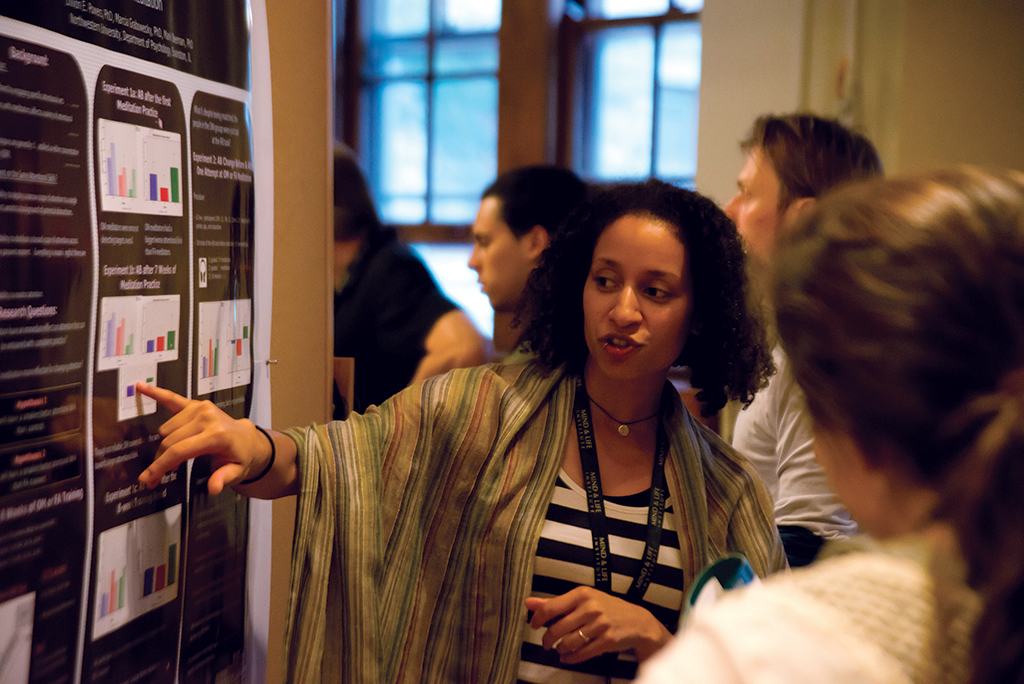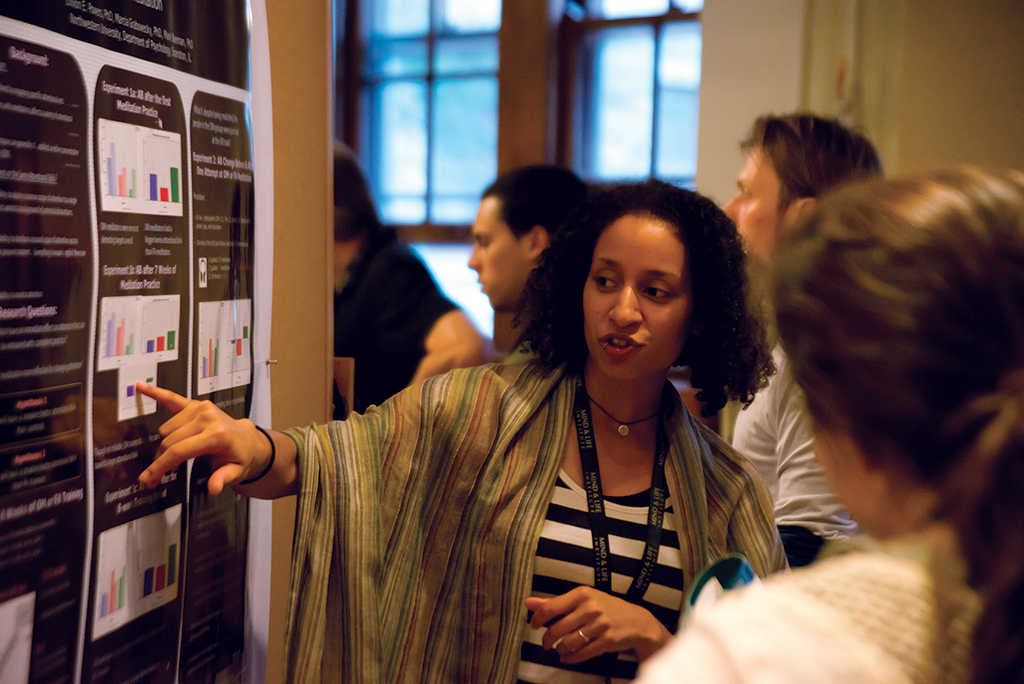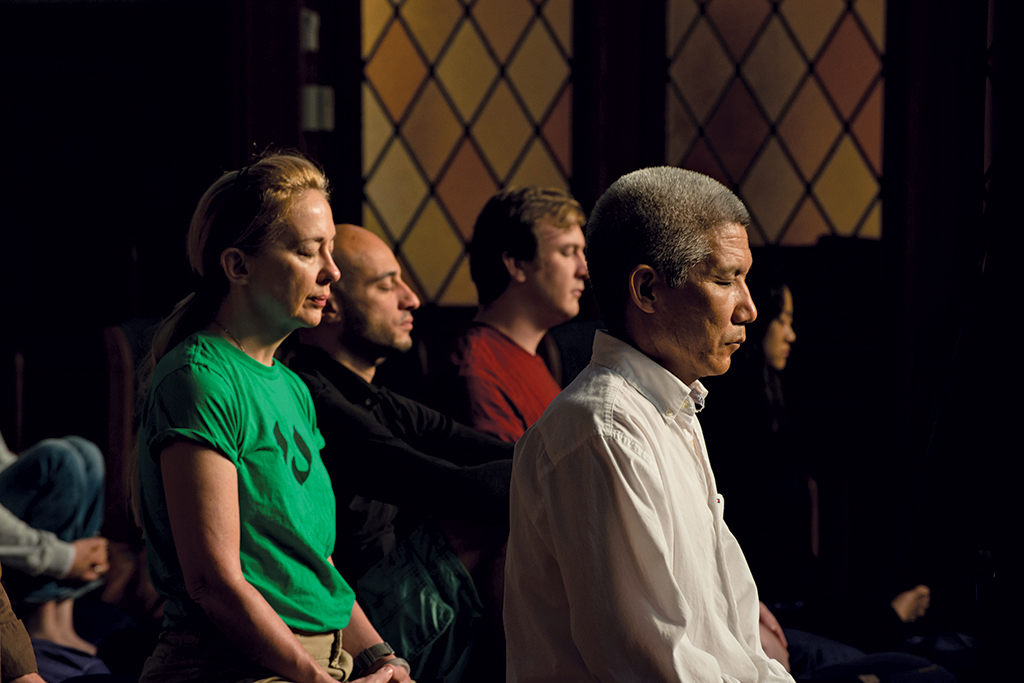
Every summer, Mind & Life brings together more than 150 scientists, contemplatives, scholars, and students for its Summer Research Institute (SRI). The gathering combines cutting-edge scientific research with the world’s oldest wisdom traditions in order to uncover groundbreaking insights into the human mind and human nature.
This year’s theme was on “mapping the mind.” In this essay, we’ve offered some of the thoughts that the six stimulating days at SRI provoked.
[mliinline uppercase=true] Meditation 1 [/mliinline] Has our understanding of the brain changed over years of research? Many of us grew up hearing about the left versus the right sides of the brain, or that one area was for language and abstract thought, while another one controlled emotions such as anger or sadness. This kind of mapping is called “functional specialization,” and for decades it has been the prevalent view in neuroscience. That’s all being turned on its, well, head. Instead of mapping by discrete areas, Luis Pessoa and other SRI neuroscientists are beginning to look at the ways in which complex neural networks more accurately describe and predict the brain’s behavior. Instead of searching for brain areas, we should be looking at neural “hubs,” where networks that influence both cognitive and emotional processes interact.

[mliinline uppercase=true] Meditation 2 [/mliinline] Most of us get distracted or daydream, so we know from experience that we’re not always good at paying attention. When we do pay attention, though, we usually understand it as a property controlled by the individual in a “top-down” manner. In other words, we assume that we direct the gaze, or spotlight, of our attention. But it’s also true that the nature of our attention changes depending on our feelings during any given moment. These “bottom-up” systems of attention are heavily influenced by our memories and emotions, and tune our orientation to the environment in interesting ways. Trauma, for example, can rewire bottom-up attentional systems and make it more likely that neutral stimuli will trigger a fear response. What is often called affective or motivational salience is just beginning to be investigated by SRI scientists such as Rebecca Todd.
[mliinline uppercase=true] Meditation 3 [/mliinline] Why do we have subjective experiences in the first place? Why does it feel like something to be a person? Scientists call this the “explanatory gap” of consciousness: the challenge in explaining how material objects—the brain—give rise to immaterial experiences—the mind. Various theories have been put forward to close the explanatory gap, though none are accepted universally. Recent research into meditation, sleep, dreams, and near-death experiences might help us get a little closer to the truth. Evan Thompson raises these questions—and some possible ways of getting answers—in his latest book, Waking, Dreaming, Being: New Light on the Self and Consciousness from Neuroscience, Meditation, and Philosophy.
[mliinline uppercase=true] Meditation 4 [/mliinline]Scientists who study meditation often interact and collaborate with Buddhists, but they don’t necessarily know the story of the Buddha. Most people working at the intersection of science and religion probably haven’t heard many of the rich narratives contained in the Buddhist canon. Sara McClintock’s presentation at SRI was a humorous and warm-hearted look at many of the most well-known Buddhist tales. It’s a point of interest how stories that have been passed down in wisdom traditions often point to the kinds of virtuous character traits that can, and are, studied by scientists and psychologists. Because these narratives share tales of radical transformations, they represent a powerful way of passing down ideas and insights to future generations.
[mliinline uppercase=true] Meditation 5 [/mliinline]Psychologist Al Kaszniak shared four ways that scientists today study consciousness. First, by looking at images of the brain during allegedly unconscious states such as comas and anesthesia. Second, by using objective research methods that try to minimize the unreliability of first-person accounts. Third, by studying the neural correlates of consciousness through brain imaging and other approaches (e.g. what areas of the brain light up when a person is feeling a specific emotion). And last, by using computers to create theoretical and computational models of consciousness. Mind & Life Visiting Scholar Marieke van Vugt, for example, is building a computational model to further understand and predict the effects of different kinds of meditation on brain and behavior.
[mliinline uppercase=true] Meditation 6 [/mliinline]Are we limited by our biology, or can we transform ourselves to meet our highest potential? Richard Davidson thinks that we can change, and for the better. He shared numerous recent findings from his lab pointing to ways that meditation and other contemplative practices make us more resilient, happy, and compassionate. Part of this quest to improve ourselves will involve building maps of human development. But, he cautioned, mapping the mind is complicated and can’t be done from one perspective alone. We will need insights from both science and contemplative traditions if we have any hope of becoming a kinder, more caring species.

[mliinline uppercase=true] Meditation 7 [/mliinline]Professor of Religion John Dunne argued that the problems inherent in mind mapping are often the generalizations science and spirituality can make. He explained that the mind, too subject to cul-tural and historical influences, may be impossible to map for all humans in all societies across time. Most studies in psychology and neuroscience, for example, use subjects who come from countries that are “WEIRD”: Western, Educated, Industrialized, Rich, and Democratic. Most people do not live in WEIRD countries, however, so conclusions that arise from these data are limited to a specific time, place, and population.
[mliinline uppercase=true] Meditation 8 [/mliinline]Science tells us that every human has the potential to change, but where do we turn for concrete instruction? One source is the collection of Tibetan practices called “meditations of innate compassion and wisdom.” John Makransky calls this “Innate Compassion Training,” and his presentation focused on pointing out the differences between compassion training and more cognitive-based meditation methods. Mind & Life intends to borrow from John Makransky and others as it begins to design a pedagogy and curriculum for compassion and ethical behavior that can be accepted by nonbelievers as well as people of faith—what the Dalai Lama calls “secular ethics.”
[mliinline uppercase=true] Meditation 9 [/mliinline]What is the difference between mapping the mind and mapping the brain? While neuroscientists are making great progress in understanding brain connectivity and function, Buddhist meditators have been investigating the phenomenology of lived experience directly through first-person practices for centuries, and have developed their own detailed maps of the territory within. Based upon such universal human features as the body and its sense organs, these maps describe the basic modes of consciousness and sensation, as well as such higher order functions as emotion, cognition, and behavior. Buddhist scholar Andrew Olendzki gives us a tour of the classical Buddhist model of the mind as lived experience, and invites modern investigators to make use of this valuable information in their their own research. See a video of the presentation here.

